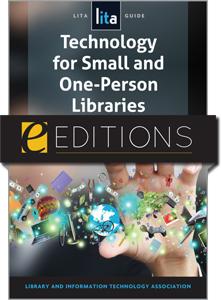
Technology for Small and One-Person Libraries: A LITA Guide--eEditions e-book
The download link for this product can be found on the final confirmation screen after you complete your purchase, and may also be accessed from your Account Profile. For more information about ALA eEditions file types and how to view them on eReaders, desktop computers, and other devices, see this page.
Primary tabs
You don't need to be an ALA Member to purchase from the ALA Store, but you'll be asked to create an online account/profile during checkout to proceed. This Web Account is for both Members and non-Members. Note that your ALA Member discount will be applied at the final step of the checkout process.
If you are Tax-Exempt, please verify that your account is currently set up as exempt before placing your order, as our new fulfillment center will need current documentation. Learn how to verify here.
- Description
- Table of Contents
- About the authors
For those working in a small library, particularly one that may have little technical support, a foundational knowledge of technology is crucial. Written for librarians, library staff, and administrators at libraries serving populations of 15,000 or less, this LITA guide shows how to successfully develop, implement, sustain, and grow technology initiatives. The contributors draw from personal experience in rural libraries and regional state university libraries to offer guidance for making sound technology decisions. Whether looking for a quick answer or starting an in-depth technology project, readers will quickly find basic information on the full range of library technology, organized into chapters with numerous headings for easy scanning. Topics include
- An overview of library technology basics
- Electronic resource fundamentals, including a look at licensing issues
- Webpage development, Open-source (OS) applications, and a six-step plan for social media and social networking
- How to create and sustain an effective technology strategy
Preface by Rene J. ErlandsonAcknowledgments
Part I Library Technology Basics
Chapter 1
Technology Plan Fundamentals by Rene J. Erlandson
Chapter 2
Hardware and Software by Rene J. Erlandson
Chapter 3
Infrastructure/Networking by Scott Childers
Chapter 4
Integrated Library Systems by Rachel A. Erb
Part II e-Resources
Chapter 5
Fundamentals of Electronic Resources
by Rachel A. Erb
Chapter 6
Licensing Electronic Resources
by Rachel A. Erb
Part III The Virtual Library
Chapter 7
Web Page Development by Rene J. Erlandson
Chapter 8
Social Media and Social Networking by Rene J. Erlandson
Chapter 9
Open-Source Applications by Rachel A. Erb
Chapter 10
Digital Collections by Nicci Westbrook
Chapter 11
Finding Help and Keeping Up with Changing Technology in Libraries by Rene J. Erlandson
GlossaryAbout the AuthorsIndex
Rene J. Erlandson
Rene J. Erlandson is the director of virtual services at the University of Nebraska Omaha (UNO) libraries, with oversight of computer systems, digital asset management, digital collection development, electronic resource management, emerging technologies, library systems, network infrastructure, and Web development. Prior to joining the University of Nebraska faculty, she worked at University of Illinois Urbana-Champaign (UIUC) and Iowa State University for two decades. As the senior cataloger and project coordinator for the Library of Congress-administered Illinois Newspaper Project at UIUC, she visited many small libraries throughout the state of Illinois and was often consulted on technology questions by librarians working in those libraries.
Rachel A. Erb
Rachel A. Erb has been working in technical services for over a decade with substantial experience in cataloging materials of various formats and in managing integrated library systems. She recently transitioned to focusing on electronic resources and is now the electronic resources management librarian at Colorado State University (CSU). She is familiar with the challenges solo practitioners face because most of her professional experience consists of working in either rural settings with limited resources or regional state universities. She has also written several case studies of technical services operations in these environments.


